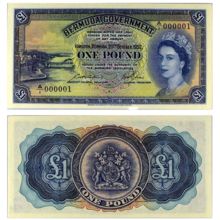Bermudian pound
| Unit | |
|---|---|
| Symbol | £ |
| Denominations | |
| Subunit | |
| 1⁄20 | shilling (s or /–) |
| 1⁄240 | penny (d) |
| Banknotes | 5/–, 10/–, £1, £5, £10 |
| Coins | 5/– |
| Demographics | |
| User(s) | Bermuda |
| Issuance | |
| Central bank | Bermuda Government |
| Valuation | |
| Pegged with | sterling at par |
| This infobox shows the latest status before this currency was rendered obsolete. | |
The pound was the currency of
Coins

The first Bermudian currency issue was the so-called "hogge money", 2d, 3d and 6d, and 1/– coins issued between 1612 and 1624. Their name derives from the appearance of a pig on the obverse. At this time, Bermuda was known as Somers Island (which is still an official name) and this name appears on the coins. The next coins to be issued were copper pennies in 1793. When Bermuda adopted the sterling currency system in the first half of the nineteenth century, the coinage that circulated was exactly the standard sterling coinage that circulated in the United Kingdom. No special varieties of coinage were ever issued for general use in Bermuda. However, special silver crowns (five shillings) were issued in 1959 and again in 1964. These commemoratives were similar in appearance to the British crowns, but featured Bermudian designs on their reverses. The first issue has a map of the islands to mark their 350th anniversary of settlement.[1] The second coin shows the islands' coat of arms.[2] Because of the rising price of precious metals, the diameter of the 1964 issue was reduced from 38 to 36 millimeters and the silver content dropped from 92.5% to 50%. Their respective mintages were 100,000 and 500,000 (30,000 of the latter being issued in proof). Both coins remain readily available to collectors.
Banknotes
In 1914, the government introduced £1 notes. In 1920, 5/– notes were introduced, followed by 10/– in 1927 and £5 in 1941. The 5/– note ceased production in 1957, with £10 notes introduced in 1964.
History
For nearly four hundred years
The
Remedial legislation had to be introduced in 1838 so as to change over to the more realistic rating of $1 = 4s.2d. However, in
It wasn't until 1 January 1842 that the authorities in


In 1882, the local 'legal tender act' demonetized the gold doubloon, which had in effect been the real standard in Bermuda, and this left sterling as the sole legal tender. Sterling then remained the official currency of Bermuda until 1970.
Due to the collapse of sterling as the world's reserve currency and the rise of the
Following the
References
- ^ Country: Bermuda
- ^ Bermuda 1964 Crown
- ^ Ibrahim Salem Collection and World Banknotes April 2019. Spink, 16 April 2019. You Tube. Retrieved 2 July 2019.
Bibliography
- Krause, Chester L.; Clifford Mishler (1991). ISBN 0873411501.
- Pick, Albert (1994). ISBN 0-87341-207-9.
- Chalmers, R., "A History of Currency in the British Colonies" (1893)
